Instructions for Side by Side Printing
- Print the notecards
- Fold each page in half along the solid vertical line
- Cut out the notecards by cutting along each horizontal dotted line
- Optional: Glue, tape or staple the ends of each notecard together
Ch 3
front 1 1) In a single molecule of water, two hydrogen atoms are bonded to a single oxygen atom by
Answer: Topic: Concept 3.1 Skill: Knowledge/Comprehension | back 1 C |
front 2 2) The slight negative charge at one end of one water molecule is attracted to the slight positive charge of another water molecule. What is this attraction called?
Answer: Topic: Concept 3.1 Skill: Knowledge/Comprehension | back 2 B |
front 3 3) The partial negative charge in a molecule of water occurs because
Answer: Topic: Concept 3.1 Skill: Knowledge/Comprehension | back 3 B |
front 4 4) Sulfur is in the same column of the periodic table as oxygen, but has electronegativity similar to carbon. Compared to water molecules, molecules of H2S
Answer: Topic: Concept 3.1 Skill: Synthesis/Evaluation | back 4 E |
front 5 5) Water molecules are able to form hydrogen bonds with
Answer: Topic: Concept 3.1 Skill: Application/Analysis | back 5 A |
front 6 6) Which of the following effects is produced by the high surface tension of water?
Answer: Topic: Concept 3.2 Skill: Application/Analysis | back 6 B |
front 7 7) Which of the following takes place as an ice cube cools a drink?
Answer: Topic: Concept 3.2 Skill: Application/Analysis | back 7 B |
front 8 8) A dietary Calorie equals 1 kilocalorie. Which of the following statements correctly defines 1 kilocalorie?
Answer: Topic: Concept 3.2 Skill: Knowledge/Comprehension | back 8 D |
front 9 9) The nutritional information on a cereal box shows that one serving of a dry cereal has 200 kilocalories. If one were to burn one serving of the cereal, the amount of heat given off would be sufficient to raise the temperature of 20 kg of water how many degrees Celsius?
Answer: Topic: Concept 3.2 Skill: Application/Analysis | back 9 D |
front 10 10) Liquid water's high specific heat is mainly a consequence of the
Answer: Topic: Concept 3.2 Skill: Knowledge/Comprehension | back 10 C |
front 11 11) Which type of bond must be broken for water to vaporize?
Answer: Topic: Concept 3.2 Skill: Knowledge/Comprehension | back 11 D |
front 12 12) Temperature usually increases when water condenses. Which behavior of water is most directly responsible for this phenomenon?
Answer: Topic: Concept 3.2 Skill: Application/Analysis | back 12 C |
front 13 13) Why does evaporation of water from a surface cause cooling of the surface?
Answer: Topic: Concept 3.2 Skill: Knowledge/Comprehension | back 13 B |
front 14 14) Why does ice float in liquid water?
Answer: Topic: Concept 3.2 Skill: Application/Analysis | back 14 D |
front 15 15) Hydrophobic substances such as vegetable oil are
Answer: Topic: Concept 3.2 Skill: Knowledge/Comprehension | back 15 A |
front 16 16) One mole (mol) of glucose (molecular mass = 180 daltons) is
Answer: Topic: Concept 3.2 Skill: Application/Analysis | back 16 E |
front 17 17) How many molecules of glucose (C6H12O6 molecular mass = 180 daltons) would be present in 90 grams of glucose?
Answer: Topic: Concept 3.2 Skill: Application/Analysis | back 17 E |
front 18 18) How many molecules of glycerol (C3H8O3; molecular mass = 92) would be present in 1 L of a 1 M glycerol solution?
Answer: Topic: Concept 3.2 Skill: Knowledge/Comprehension | back 18 E |
front 19 19) When an ionic compound such as sodium chloride (NaCl) is placed in water, the component atoms of the NaCl crystal dissociate into individual sodium ions (Na+) and chloride ions (Cl-). In contrast, the atoms of covalently bonded molecules (e.g., glucose, sucrose, glycerol) do not generally dissociate when placed in aqueous solution. Which of the following solutions would be expected to contain the greatest number of solute particles (molecules or ions)?
Answer: Topic: Concept 3.2 Skill: Application/Analysis | back 19 C |
front 20 20) The molar mass of glucose is 180 g/mol. Which of the following procedures should you carry out to make a 1 M solution of glucose?
Answer: Topic: Concept 3.2 Skill: Application/Analysis | back 20 E |
front 21 21) The molar mass of glucose (C6H12O6) is 180 g/mol. Which of the following procedures should you carry out to make a 0.5 M solution of glucose?
Answer: Topic: Concept 3.2 Skill: Application/Analysis | back 21 B |
front 22 22) You have a freshly prepared 0.1 M solution of glucose in water. Each liter of this solution contains how many glucose molecules?
Answer: Topic: Concept 3.2 Skill: Application/Analysis | back 22 E |
front 23 23) The molecular weight of water is 18 daltons. What is the molarity of 1 liter of pure water? (Hint: What is the mass of 1 liter of pure water?)
Answer: \ Topic: Concept 3.2 Skill: Synthesis/Evaluation | back 23 A |
front 24 24) You have a freshly prepared 1 M solution of glucose in water. You carefully pour out a 100 mL sample of that solution. How many glucose molecules are included in that 100 mL sample?
Answer: Topic: Concept 3.2 Skill: Application/Analysis | back 24 E |
front 25 25) A strong acid like HCl
Answer: Topic: Concept 3.3 Skill: Application/Analysis | back 25 A |
front 26 26) Which of the following ionizes completely in solution and is considered to be a strong base (alkali)?
Answer: Topic: Concept 3.3 Skill: Knowledge/Comprehension | back 26 E |
front 27 27) A 0.01 M solution of a substance has a pH of 2. What can you conclude about this substance?
Answer: Topic: Concept 3.3 Skill: Application/Analysis | back 27 A |
front 28 28) A given solution contains 0.0001(10-4) moles of hydrogen ions [H+] per liter. Which of the following best describes this solution?
Answer: Topic: Concept 3.3 Skill: Application/Analysis | back 28 C |
front 29 29) A solution contains 0.0000001(10-7) moles of hydroxyl ions [OH-] per liter. Which of the following best describes this solution?
Answer: Topic: Concept 3.3 Skill: Application/Analysis | back 29 E |
front 30 30) What is the pH of a solution with a hydroxyl ion [OH-] concentration of 10-12 M?
Answer: Topic: Concept 3.3 Skill: Application/Analysis | back 30 A |
front 31 31) What is the pH of a 1 millimolar NaOH solution?
Answer: Topic: Concept 3.3 Skill: Application/Analysis | back 31 E |
front 32 32) Which of the following solutions would require the greatest amount of base to be added to bring the solution to neutral pH?
Answer: Topic: Concept 3.3 Skill: Knowledge/Comprehension | back 32 A |
front 33 33) What is the hydrogen ion [H+] concentration of a solution of pH 8?
Answer: Topic: Concept 3.3 Skill: Knowledge/Comprehension | back 33 D |
front 34 34) If the pH of a solution is decreased from 9 to 8, it means that the
Answer: Topic: Concept 3.3 Skill: Application/Analysis | back 34 E |
front 35 35) If the pH of a solution is increased from pH 5 to pH 7, it means that the
Answer: Topic: Concept 3.3 Skill: Application/Analysis | back 35 C |
front 36 36) One liter of a solution of pH 2 has how many more hydrogen ions (H+) than 1 L of a solution of pH 6?
Answer: Topic: Concept 3.3 Skill: Application/Analysis | back 36 D |
front 37 37) One liter of a solution of pH 9 has how many more hydroxyl ions (OH-) than 1 L of a solution of pH 4?
Answer: Topic: Concept 3.3 Skill: Application/Analysis | back 37 E |
front 38 38) Which of the following statements is true about buffer solutions?
Answer: Topic: Concept 3.3 Skill: Knowledge/Comprehension | back 38 D |
front 39 39) Buffers are substances that help resist shifts in pH by
Answer: Topic: Concept 3.3 Skill: Knowledge/Comprehension | back 39 E |
front 40 40) One of the buffers that contribute to pH stability in human blood is carbonic acid (H2CO3). Carbonic acid is a weak acid that dissociates into a bicarbonate ion (HCO3-) and a hydrogen ion (H+). Thus, H2CO3 ↔ HCO3- + H+ If the pH of the blood drops, one would expect
Answer: Topic: Concept 3.3 Skill: Application/Analysis | back 40 D |
front 41 41) One of the buffers that contribute to pH stability in human blood is carbonic acid (H2CO3). Carbonic acid is a weak acid that, when placed in an aqueous solution, dissociates into a bicarbonate ion (HCO3- and a hydrogen ion (H+). Thus, H2CO3 ↔ HCO3- + H+ If the pH of the blood increases, one would expect
Answer: Topic: Concept 3.3 Skill: Application/Analysis | back 41 A |
front 42 42) Assume that acid rain has lowered the pH of a particular lake to pH 4.0. What is the hydroxyl ion concentration of this lake?
Answer: Topic: Concept 3.3 Skill: Application/Analysis | back 42 A |
front 43 43) Research indicates that acid precipitation can damage living organisms by
Answer: Topic: Concept 3.3 Skill: Knowledge/Comprehension | back 43 D |
front 44 44) Consider two solutions: solution X has a pH of 4; solution Y has a pH of 7. From this information, we can reasonably conclude that
Answer: Topic: Concept 3.3 Skill: Application/Analysis | back 44 E |
front 45 45) If a solution has a pH of 7, this means that
Answer: Topic: Concept 3.3 Skill: Knowledge/Comprehension | back 45 C |
front 46 46) Carbon dioxide (CO2) is readily soluble in water, according to the equation CO2 + H2O ↔ H2CO3. Carbonic acid (H2CO3) is a weak acid. Respiring cells release CO2 into the bloodstream. What will be the effect on pH of blood as that blood first comes in contact with respiring cells?
Answer: Topic: Concept 3.3 Skill: Synthesis/Evaluation | back 46 A |
front 47 47) A beaker contains 100 mL of NaOH solution at pH = 13. A technician carefully pours into the beaker 10 mL of HCl at pH = 1. Which of the following statements correctly describes the results of this mixing?
Answer: Topic: Concept 3.3 Skill: Synthesis/Evaluation | back 47 E |
front 48 48) Equal volumes (5 mL) of vinegar from a freshly opened bottle are added to each of the following solutions. After complete mixing, which of the mixtures will have the highest pH?
Answer: Topic: Concept 3.3 Skill: Synthesis/Evaluation | back 48 C |
front 49 49) Increased atmospheric CO2 concentrations might have what effect on seawater?
Answer: Topic: Concept 3.3 Skill: Knowledge/Comprehension | back 49 D |
front 50 50) How would acidification of seawater affect marine organisms?
Answer: Topic: Concept 3.3 Skill: Knowledge/Comprehension | back 50 D |
front 51 51) One idea to mitigate the effects of burning fossil fuels on atmospheric CO2 concentrations is to pipe liquid CO2 into the ocean at depths of 2,500 feet or greater. At the high pressures at such depths, CO2 is heavier than water. What potential effects might result from implementing such a scheme?
Answer: Topic: Concept 3.3 Skill: Synthesis/Evaluation | back 51 E |
front 52 52) If the cytoplasm of a cell is at pH 7, and the mitochondrial matrix is at pH 8, this means that
Answer: Topic: Concept 3.3 Skill: Application/Analysis | back 52 A |
front 53 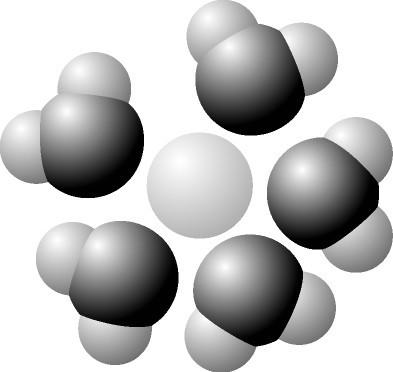 53) Based on your knowledge of the polarity of water molecules, the solute molecule depicted here is most likely
Answer: Topic: Concept 3.2 Skill: Application/Analysis | back 53 A |
front 54 54) How many grams would be equal to 1 mol of the compound shown in the figure above? (carbon = 12, oxygen = 16, hydrogen = 1)
Answer: Topic: Concept 3.2 Skill: Application/Analysis | back 54 C |
front 55 55) How many grams of the compound in the figure above would be required to make 1 L of a 0.5 M solution? (carbon = 12, oxygen = 16, hydrogen = 1)
Answer: Topic: Concept 3.2 Skill: Application/Analysis | back 55 B |
front 56 56) How many grams of the compound in the figure above would be required to make 2.5 L of a 1 M solution? (carbon = 12, oxygen = 16, hydrogen = 1)
Answer: Topic: Concept 3.2 Skill: Application/Analysis | back 56 D |
front 57 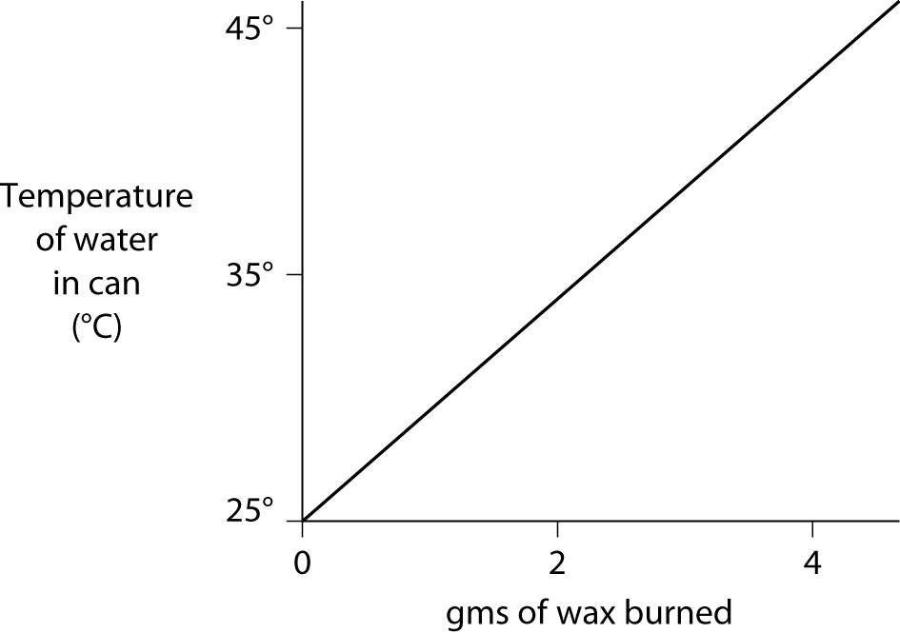 57) A small birthday candle is weighed, then lighted and placed beneath a metal can containing 100 mL of water. Careful records are kept as the temperature of the water rises. Data from this experiment are shown on the graph. What amount of heat energy is released in the burning of candle wax?
Answer: Topic: Concept 3.2 Skill: Synthesis/Evaluation | back 57 A |
front 58 58) Identical heat lamps are arranged to shine on identical containers of water and methanol (wood alcohol), so that each liquid absorbs the same amount of energy minute by minute. The covalent bonds of methanol molecules are nonpolar, so there are no hydrogen bonds among methanol molecules. Which of the following graphs correctly describes what will happen to the temperature of the water and the methanol? | back 58 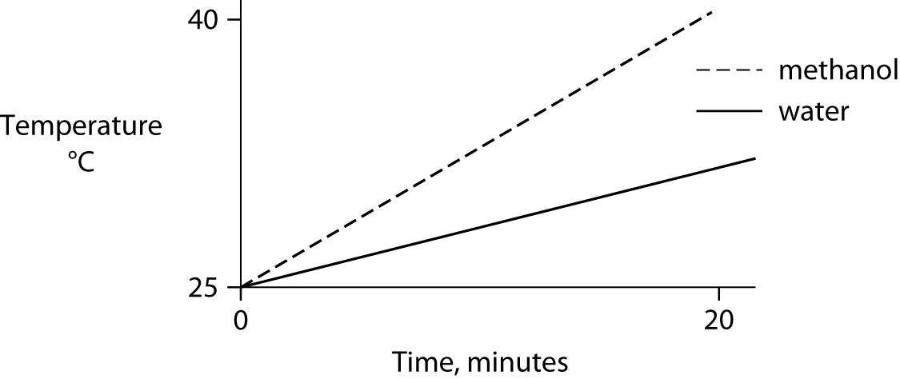 B |
front 59 59) Which of these molecules would be soluble in water? | back 59 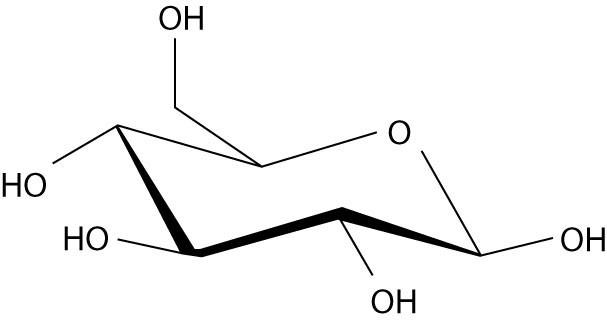 B |
front 60 60) Carbon dioxide (CO2) is readily soluble in water, according to the equation CO2 + H2O ↔ H2CO3. Carbonic acid (H2CO3) is a weak acid. If CO2 is bubbled into a beaker containing pure, freshly distilled water, which of the following graphs correctly describes the results?
| back 60 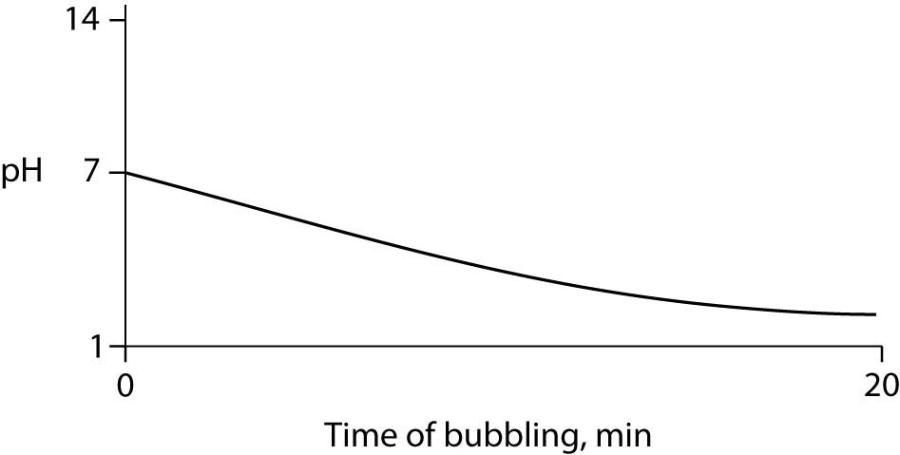 B |
front 61 61) You have two beakers. One contains pure water, the other contains pure methanol (wood alcohol). The covalent bonds of methanol molecules are nonpolar, so there are no hydrogen bonds among methanol molecules. You pour crystals of table salt (NaCl) into each beaker. Predict what will happen.
Answer: Topic: Concept 3.3 Skill: Application/Analysis | back 61 C |
front 62 62) You have two beakers. One contains a solution of HCl at pH = 1.0. The other contains a solution of NaOH at pH = 13. Into a third beaker, you slowly and cautiously pour 20 mL of the HCl and 20 mL of the NaOH. After complete stirring, the pH of the mixture will be
Answer: Topic: Concept 3.3 Skill: Synthesis/Evaluation | back 62 C |
front 63 63) Many mammals control their body temperature by sweating. Which property of water is most directly responsible for the ability of sweat to lower body temperature?
Answer: Topic: End-of-Chapter Questions Skill: Knowledge/Comprehension | back 63 D |
front 64 64) The bonds that are broken when water vaporizes are
Answer: Topic: End-of-Chapter Questions Skill: Knowledge/Comprehension | back 64 B |
front 65 65) Which of the following is a hydrophobic material?
Answer: Topic: End-of-Chapter Questions Skill: Knowledge/Comprehension | back 65 C |
front 66 66) We can be sure that a mole of table sugar and a mole of vitamin C are equal in their
Answer: Topic: End-of-Chapter Questions Skill: Knowledge/Comprehension | back 66 E |
front 67 67) Measurements show that the pH of a particular lake is 4.0. What is the hydrogen ion concentration of the lake?
Answer: Topic: End-of-Chapter Questions Skill: Knowledge/Comprehension | back 67 C |
front 68 68) Measurements show that the pH of a particular lake is 4.0. What is the hydroxide ion concentration of the lake?
Answer: Topic: End-of-Chapter Questions Skill: Knowledge/Comprehension | back 68 A |
front 69 69) A slice of pizza has 500 kcal. If we could burn the pizza and use all the heat to warm a 50-L container of cold water, what would be the approximate increase in the temperature of the water? (Note: A liter of cold water weighs about 1 kg.)
Answer: Topic: End-of-Chapter Questions Skill: Application/Analysis | back 69 E |
front 70 70) How many grams of acetic acid (C2H4O2) would you use to make 10 L of a 0.1 M aqueous solution of acetic acid? (Note: The atomic masses, in daltons, are approximately 12 for carbon, 1 for hydrogen, and 16 for oxygen.)
Answer: Topic: End-of-Chapter Questions Skill: Application/Analysis | back 70 D |